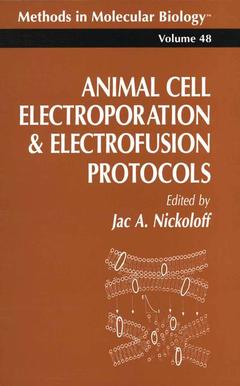Description
Animal Cell Electroporation and Electrofusion Protocols, 1995
Methods in Molecular Biology Series, Vol. 48
Language: English
Subject for Animal Cell Electroporation and Electrofusion Protocols:
370 p.
· 15.2x22.9 cm
· Paperback
Description
/li>Contents
/li>
The ability to introduce macromolecules into animal cells, includ ing DNA, RNA, proteins, and other bioactive compounds has facili tated a broad range of biological studies, from biochemistry and biophysics to molecular biology, cell biology, and whole animal stud ies. Gene transfer technology in particular will continue to play an essential role in studies aimed at improving our understanding of the relationships between the gene structure and function, and it has impor tant practical applications in both biotechnology and biomedicine, as evidenced by the current intense interest in gene therapy. Although DNA and other macromolecules may be introduced into cells by a variety of methods, including chemical treatments and microinjection, el- troporation has proven to be simpler to perform, more efficient, and effective with a wider variety of cell types than other techniques. The early and broad success of electric field-mediated DNA transfer soon prompted researchers to investigate electroporation for transferring other types of molecules into cells, including RNA, enzymes, antibodies, and analytic dyes. Animal Cell Electroporation and Electrofusion Protocols begins with three chapters that describe the theoretical and practical aspects of electroporation, including a review of the commercially available instrumentation. These introductory chapters will be of particular inter est to those new to electric field technologies and to those developing protocols for as yet untested species or cell types. Nineteen chapters follow that present well-tested protocols for electroporation of proteins and DNA into insect, fish, and mammalian cells.
Theory and Instrumentation.- Electroporation Theory.- Effects of Pulse Length and Strength on Electroporation Efficiency.- Instrumentation.- Electroporation Protocols.- The Introduction of Proteins into Mammalian Cells by Electroporation.- Electroporation of Antigen-Presenting Cells for T-Cell Recognition and Cytotoxic T-Lymphocyte Priming.- Electroporation of Antibodies into Mammalian Cells.- Electroporation of Adherent Cells In Situ for the Introduction of Nonpermeant Molecules.- Electrotransformation of Chinese Hamster Ovary Cells.- Electroporation of Rat Pituitary Cells.- Electroporation of Plasmid DNA into Normal Human Fibroblasts.- Electroporation-Mediated Gene Transfer into Hepatocytes.- Electroporation of Human Lymphoblastoid Cells.- The Use of Electroporated Bovine Spermatozoa to Transfer Foreign DNA into Oocytes.- Electroporation of Embryonic Stem Cells for Generating Transgenic Mice and Studying In Vitro Differentiation.- Electrotransfection with “Intracellular” Buffer.- Effect of Cis-Located Human Satellite DNA on Electroporation Efficiency.- Quantitation of Transient Gene Expression.- Stable Integration of Vectors at High Copy Number for High-Level Expression in Animal Cells.- Electroporation of Drosophila Embryos.- Transformation of Fish Cells and Embryos.- Electroporation of Cardiac Cells.- Electroporation for Gene Therapy.- Electrofusion Protocols.- Electrofusion of Mammalian Cells.- Stabilizing Antibody Secretion of Human Epstein Barr Virus-Activated B-Lymphocytes with Hybridoma Formation by Electrofusion.- Electrofusion of Mammalian Oocytes and Embryonic Cells.- Nuclear Transfer in Bovine Embryos.- Electrofusion of Mouse Embryos to Produce Tetraploids.- Spectrofluorometric Assay for Cell-Tissue Electrofusion.- Cytometric Detection and Quantitationof Cell-Cell Electrofusion Products.
© 2024 LAVOISIER S.A.S.




